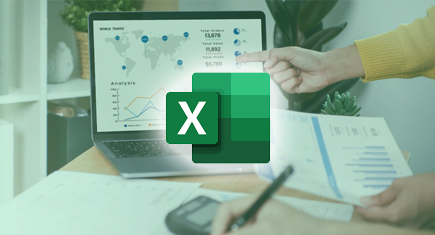This plan includes
- Instant access to 11,000+ online courses
- Play & Pause Course Videos
 HD Video Recorded Lectures
HD Video Recorded Lectures- Learn on Mobile/PC/Tablet
- Quizzes and Real Projects
- Lifetime Course Certificate
- Instructor Chat Support
- Cancel Plan Anytime
What you'll learn?
- Explain how the balance sheet, income statement, and statement of cash flows are used, what they measure, and why we need three statements.
- Differentiate between income and cash flow
- Explain what is the balance sheet equation and why the balance sheet equation is the foundational model for accrual accounting/double entry accounting
- Define what are assets, liabilities, and equity and how assets, liabilities, and equity relate
- Explain how the statement of cash flows and income statement link into the balance sheet
- Explain how accounts work like buckets
- Locate a real company’s annual report at their website and locate their financial statements within the annual report
- Explain who are the six most important stakeholders of a corporation (employees, customers, government, vendors, lenders, investors)
- Explain the give and take of a transaction and how to record both sides of the transaction separately with the six stakeholders
- Explain what each line item of the balance sheet means and distinguish between current assets, non-current assets, current liabilities, non-current liabilities, and shareholders’ equity
- Explain which side of the give and take appears on the income statement and on the statement of cash flows
- Explain why you can’t measure profit with cash and why you need to use accrual accounting (double-entry accounting), not cash accounting
- Illustrate how accrual accounting can both record cash and profits using a spreadsheet
- Explain the basis for bookkeeping and basic accounting without learning bookkeeping
- Explain what each line item of the balance sheet means and distinguish between current and noncurrent assets, liabilities, and shareholders’ equity
- Explain what each line item of the income statement means, including revenues, expenses, and earnings per share
- Explain each important line item for the three sections of the statement of cash flows: operating activities, investing activities, and financing activities
- Explain how the format of the operating activities section differs from the other two activities (investing and financing)
- Test your knowledge by completing 28 multiple-choice questions about the 2013 Facebook annual report
- Explain four areas that can go wrong in a business (sales pricing, expense control, asset management, and asset financing)
- Explain how four ratios (return on equity, profit margin, asset turnover, and financial leverage) can detect problems within the four potential problem areas
- Compute return on equity, profit margin, asset turnover, and financial leverage ratios from real company’s financial statements
- For the return on equity ratio, drill down into its three component ratios (profit margin, asset turnover, and financial leverage) to pinpoint problem areas
- Start with the profit margin ratio and drill down to compute the gross profit percentage and expense percentage from a real company’s financial statements
- Locate management’s explanation for year-to-year changes in ratios from the company’s annual report
- Summarize the key reasons for return on equity variations for a real company from year-to-year
- Explain how four industries (distribution, manufacturing, service, and financial services differ in the way they make money
- Explain how the profit margin, asset turnover, and financial leverage ratios can reveal the key differences in the way that four industries make money
Course Overview
"The number one problem in today's generation and economy is the lack of financial literacy" - Alan Greenspan, Chairman of the U. S. Federal Reserve 1987 to 2006
If you are in business, you need to speak the language. No matter if you’re in sales, marketing, manufacturing, purchasing, accounting, or finance, you need to speak the language of business. Perhaps you own a small business or are an entrepreneur starting a business… or you need a better job and are thinking about going to business school… or you provide legal and consulting services to businesses. You’ll be more credible, make better decisions, and enjoy more success if you speak the language of business.
The Importance of Financial Statements in Today’s World
The language of business is encapsulated in financial statements. Financial statements provide a scorecard for how a business is doing. Over a series of years, it provides a map of the business’s performance. Managers judge the success of their business with financial statements. Investors make intelligent investing decisions with financial statements. In addition, people in the business world are being held more accountable for their financial statement practices since Enron and WorldCom. They need to know what goes into financial statements.
Learn to Read Financial Statements, Not Prepare Them.
Just as you don’t need to understand how to make a car in order to drive one, you don’t have to understand bookkeeping to read financial statements. I've prepared a course that eliminates the bookkeeping drudgery and concentrates on the end product of accounting, how to read financial statements, not how to prepare them.
Like climbing a spiral staircase, I will teach you how to read three real company’s financial statements (Whole Foods, Sherwin Williams, and Facebook), starting with the simple and progressing to the complex, interspersing the statements with key accounting terms and concepts to help you build expertise.
Sounds good? Here is exactly what we will cover:
- Read Financial Statements. What is a balance sheet, income statement and statement of cash flows and how each is different
- Quick Look: Read Financial Statements of Whole Foods. What are the major line items on Whole Foods’ balance sheet, income statement and statement of cash flows
- Where the numbers come from: Accrual Accounting Basics. What are some basic accounting concepts, why we can’t measure profits with cash, and why we need a separate statement for income and cash flow
- Deep Dive: Read Financial Statements of Sherwin Williams. What each line item means on Sherwin Williams’ balance sheet, income statement and statement of cash flows
- Test What you have learned: Facebook Case Study. A 28-question quiz about Facebook’s balance sheet, income statement and statement of cash flows with feedback
- What the Financial Statements Tell You Through Ratios. How to interpret a company’s performance with four ratios: return on equity, profit margin, asset turnover, and financial leverage. How to compute these ratios for Sherwin Williams and dig into their annual report for insight. How to compare financial statements among four different industries (distribution, manufacturing, service, and financial service)
The course contains 20 three-to-eight-minute-videos each followed by a multiple-choice quiz. A case is provided for Facebook.
The course will take 100 minutes to view the videos and another 45 minutes to take the quizzes and do the Facebook case.
Are you ready? Let's do this.
Pre-requisites
- No requirements
Target Audience
- Anyone who seeks to understand financial statements, such as investors, business people, students
Curriculum 26 Lectures 02:16:20
-
Section 1 : Read Basic Financial Statements
- Lecture 2 :
- What are Financial Statements
- Lecture 3 :
- The Balance Sheet Equation
- Lecture 4 :
- How Do Financial Statements Relate?
-
Section 2 : Quick Look: Read Financial Statements of Whole Foods
- Lecture 1 :
- Whole Foods Balance Sheet
- Lecture 2 :
- Whole Foods Statement of Operations
- Lecture 3 :
- Whole Foods Statement of Cash Flows
-
Section 3 : Where the numbers come from: Accrual Accounting Basics
- Lecture 1 :
- Accrual Accounting Basics
- Lecture 2 :
- Can't Measure Profit with Cash
- Lecture 3 :
- How Accrual Accounting Measures Both Cash and Profit
-
Section 4 : Deep Dive: Read Financial Statements of Sherwin Williams
- Lecture 1 :
- Sherwin Williams Balance Sheet
- Lecture 2 :
- Sherwin Williams Statement of Operations
- Lecture 3 :
- Sherwin Williams Statement of Cash Flows
-
Section 5 : Test What you have learned: Facebook Case Study
- Lecture 1 :
- Facebook Case with Answers
-
Section 6 : What the Financial Statements Tell You Through Ratios
- Lecture 1 :
- Introduction to Key Ratios
- Lecture 2 :
- Compute Sherwin Williams' Return on Equity
- Lecture 3 :
- Compute Sherwin Williams' Profit Margin
- Lecture 4 :
- Compute Sherwin Williams' Asset Turnover
- Lecture 5 :
- Compute Sherwin Williams' Financial Leverage
- Lecture 6 :
- Compare Key Ratios Among Companies
-
Section 7 : Section 7 Update of Financial Statements and Ratios from 2013 to 2019
- Lecture 1 :
- Introduction to New Update Module
- Lecture 2 :
- Update Sherwin-Williams Financial Statements 2013 to 2019
- Lecture 3 :
- Update Facebook Financial Statements 2013 to 2019
- Lecture 4 :
- Update Whole Foods Financial Statements 2013 to 2017
- Lecture 5 :
- Ratio Comparison of Three Companies 2013 to 2019
- Lecture 6 :
- Stock Performance 2013 to 2019
Our learners work at
Frequently Asked Questions
-
How do i access the course after purchase?
It's simple. When you sign up, you'll immediately have unlimited viewing of thousands of expert courses, paths to guide your learning, tools to measure your skills and hands-on resources like exercise files. There’s no limit on what you can learn and you can cancel at any time. -
Are these video based online self-learning courses?
Yes. All of the courses comes with online video based lectures created by certified instructors. Instructors have crafted these courses with a blend of high quality interactive videos, lectures, quizzes & real world projects to give you an indepth knowledge about the topic. -
Can i play & pause the course as per my convenience?
Yes absolutely & thats one of the advantage of self-paced courses. You can anytime pause or resume the course & come back & forth from one lecture to another lecture, play the videos mulitple times & so on. -
How do i contact the instructor for any doubts or questions?
Most of these courses have general questions & answers already covered within the course lectures. However, if you need any further help from the instructor, you can use the inbuilt Chat with Instructor option to send a message to an instructor & they will reply you within 24 hours. You can ask as many questions as you want. -
Do i need a pc to access the course or can i do it on mobile & tablet as well?
Brilliant question? Isn't it? You can access the courses on any device like PC, Mobile, Tablet & even on a smart tv. For mobile & a tablet you can download the Learnfly android or an iOS app. If mobile app is not available in your country, you can access the course directly by visting our website, its fully mobile friendly. -
Do i get any certificate for the courses?
Yes. Once you complete any course on our platform along with provided assessments by the instructor, you will be eligble to get certificate of course completion.
-
For how long can i access my course on the platform?
You require an active subscription to access courses on our platform. If your subscription is active, you can access any course on our platform with no restrictions. -
Is there any free trial?
Currently, we do not offer any free trial. -
Can i cancel anytime?
Yes, you can cancel your subscription at any time. Your subscription will auto-renew until you cancel, but why would you want to?
Instructor

11719 Course Views
1 Courses



 Tech & IT
Tech & IT
 Business
Business
 Coding & Developer
Coding & Developer
 Finance & Accounting
Finance & Accounting
 Academics
Academics
 Office Applications
Office Applications
 Art & Design
Art & Design
 Marketing
Marketing
 Health & Wellness
Health & Wellness
 Sounds & Music
Sounds & Music
 Lifestyle
Lifestyle
 Photography
Photography



















